Purebred Dalmatian Dog Breed Information
The Dalmatian stands out with its distinctive spotted coat and graceful presence, captivating dog enthusiasts everywhere. Initially, these dogs served multiple roles, from protecting to providing companionship, showing their ability to adapt to various situations.
Their spots, a result of a genetic mutation, not only set them apart visually but also raise questions about the effects of selective breeding on their health. The Dalmatian’s history, from its origins in Dalmatia to becoming a fixture in firehouses and family homes, tells a fascinating story. It also prompts us to consider the breed’s future amidst current breeding trends and domestic demands.
This leads to discussions about the roles of breeders and pet owners in maintaining the Dalmatian’s heritage and ensuring a healthy future for these dogs.
Key Takeaways
- Dalmatians are known for their unique spots and versatility.
- Selective breeding impacts their health and raises ethical concerns.
- Breeders and owners share responsibility for the breed’s future.
Quick Facts
Dalmatians are a unique breed of dog known for their iconic spots and muscular build. They typically have black or dark brown spots on their white fur and are known for being strong and active. These dogs stand around 19 to 24 inches tall and weigh about 45 to 70 pounds.
Their spotted coats are the most recognizable feature they have. With roots traced back to ancient times, Dalmatians became well-known as carriage dogs.
Unfortunately, they are prone to specific health problems, including hearing problems and urinary stones, which can affect their lifespan of 11 to 13 years.
The Dalmatian-Pointer Backcross Project is an initiative to address some of the breed’s genetic health problems by reintroducing a gene responsible for standard uric acid processing.
Dalmatian Dog Breed Pictures
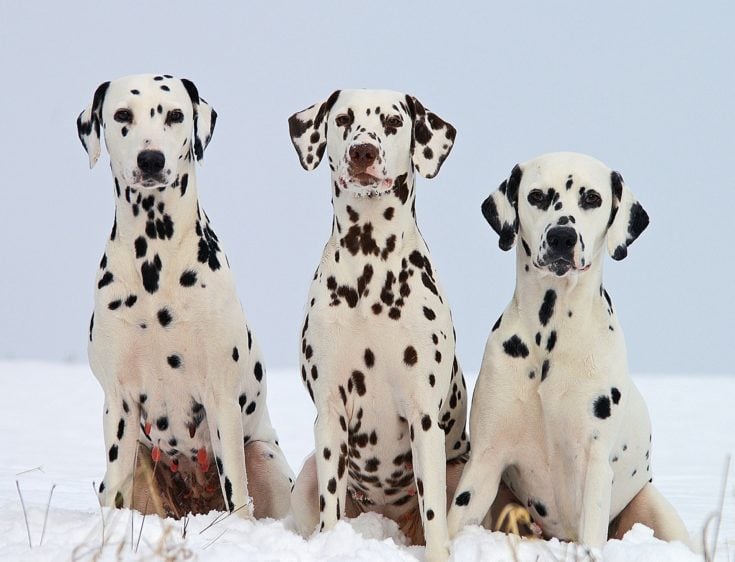
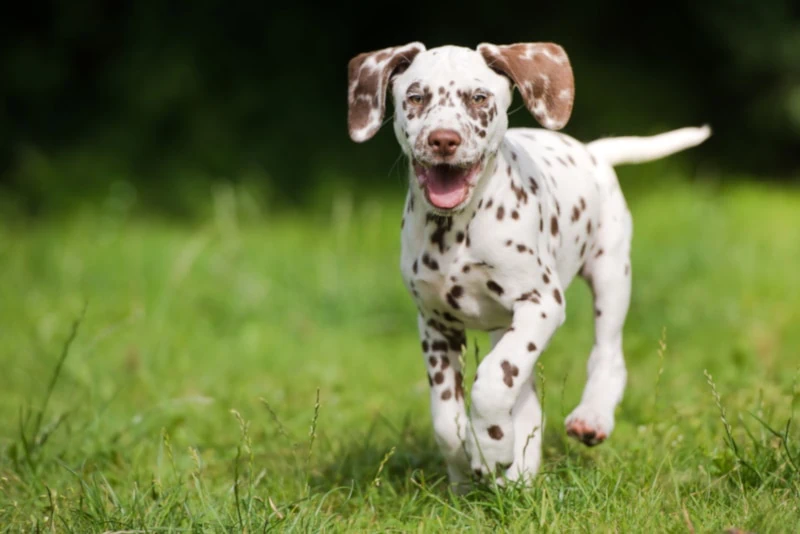
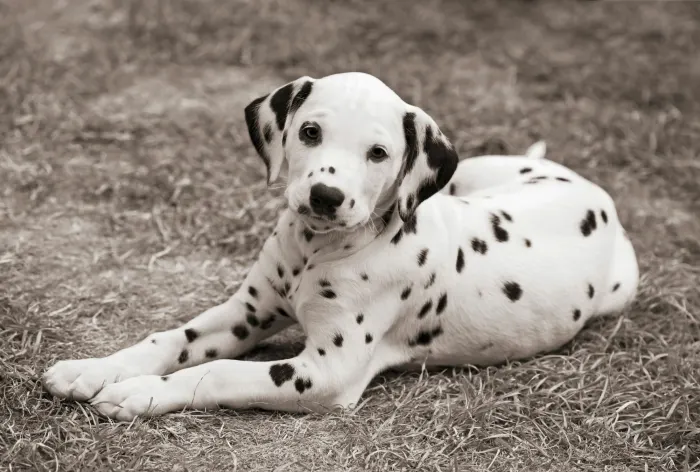
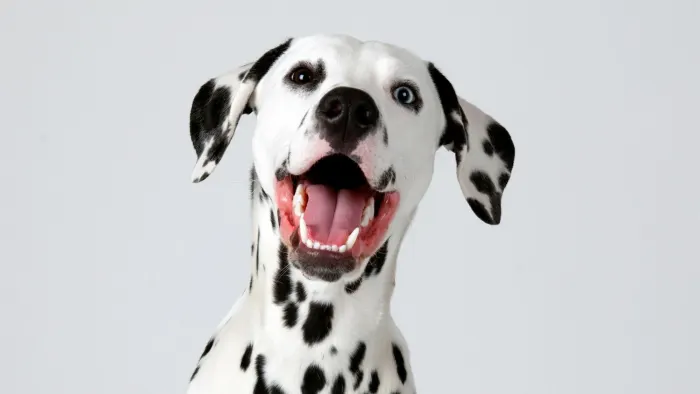
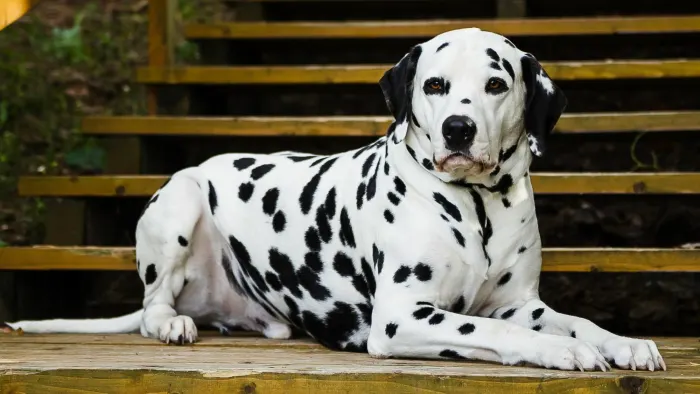
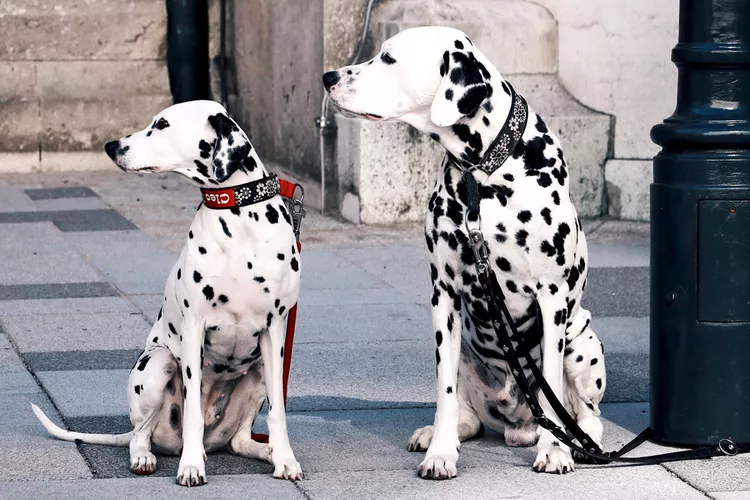
Overview
Renowned for their distinctive spotted coats, members of the Canis lupus familiaris subspecies, specifically the Dalmatian breed, exhibit a confluence of aesthetic appeal and functional athleticism. This medium-sized breed averages between 19 and 24 inches in height and tips the scales at 45 to 70 pounds. The breed’s life expectancy ranges from 11 to 13 years.
Their short, dense, and smooth spotted coats—featuring black or liver-colored spots against a white background—emerge approximately ten days postpartum. Dalmatians are genetically predisposed to specific pathologies, including deafness, urolithiasis, and urinary tract disorders, necessitating proactive health surveillance and nutritional management.
Historically, their roles spanned from guardianship to carriage dogs, with an entrenched cultural presence underscored by literary and media portrayals and commercial mascot duties.
Distinctive Spots and Energetic Spirit of Dalmatians
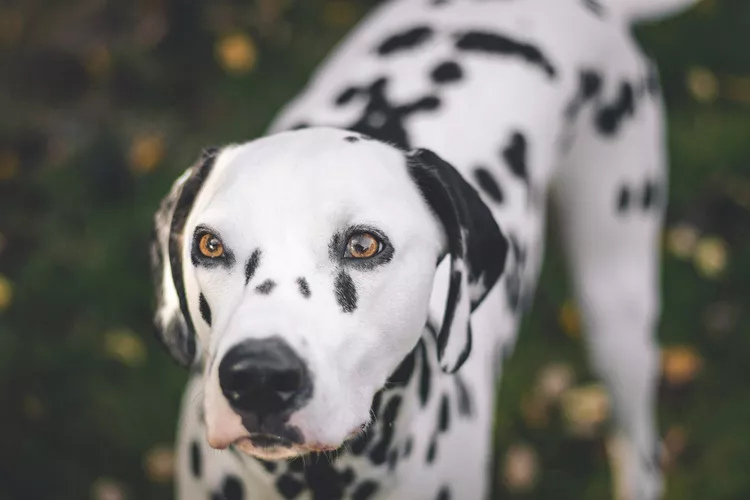
The Dalmatian pup is known for its distinctive coat pattern, featuring black or liver spots against a white background. This breed’s lively personality requires plenty of physical activity to stay healthy and avoid behavioral problems. The marks on a Dalmatian’s coat are a vital feature resulting from specific genetic traits. They have a storied past as carriage dogs, where their stamina and vigor were essential.
| Trait | Description |
|---|---|
| Spotted Coat | Black or liver spots on a white base |
| Temperament | Energetic, needs engaging activities |
| Exercise | Risk of deafness and urinary issues; needs regular vet care |
| Health Concerns | Risk of deafness urinary issues; needs regular vet care |
Regular vet visits are crucial for Dalmatians to catch any breed-specific health issues early and maintain a healthy diet for their urinary health.
Dalmatians are not just eye-catching; they’re also energetic and require an active lifestyle. Their unique spots make them stand out, but their heritage as former carriage dogs explains their need for regular exercise. They can become restless and develop behavioral issues if they don’t get it.
The importance of vet visits can’t be overstated for these dogs. Regular health checks help manage risks like deafness and urinary stones. A proper diet, monitored by a vet, can support their urinary health and overall well-being.
Origins and Evolution
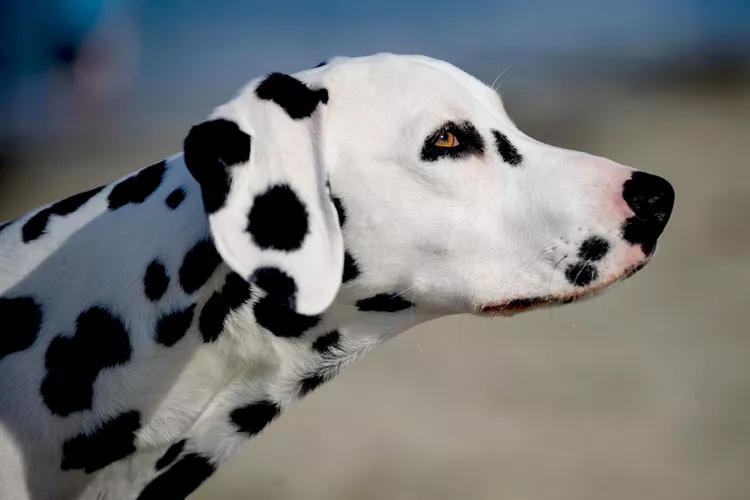
- The Dalmatian breed has its roots in the area once known as Dalmatia. The exact lineage of these dogs is not fully understood.
- Selective breeding has played a significant role in shaping the Dalmatian. They’ve been bred for various jobs, from being watchful protectors to friendly companions.
- The breed’s iconic spots are one of the evolutionary features that make Dalmatians stand out as a distinct type of dog.
- We are unraveling the Dalmatian’s ancestral history.
- I was reviewing the breed’s historical progression.
- We are examining the breed’s distinct evolutionary characteristics.
Dalmatian Ancestral Roots
Dalmatians have a fascinating history that dates back to ancient times. These dogs were initially bred in various roles, such as protectors and helpers in transportation. They became famous as carriage dogs, primarily known as English Coach Dogs. This role highlighted their ability to endure long distances, move quickly, and stay alert, qualities that breeders carefully developed over time.
The breed’s most recognizable feature is its distinctive coat with black or liver spots appearing soon after birth. Unfortunately, Dalmatians are also prone to some health problems, including sensorineural deafness, which affects many dogs within the breed.
Today, Dalmatians are often found as family pets, participating in dog shows and working in various capacities. This shift shows their versatility and the lasting impression they have made over the centuries.
Historical Breed Development
Tracing its roots to the Dalmatia region in Croatia, the Dalmatian has a rich history shaped by selective breeding. These dogs were prized for their endurance, smarts, and iconic spots. Initially serving as protectors, their roles expanded to include being reliable carriage dogs due to their versatility. This versatility is a testament to their robustness and consistent behavior.
Dalmatians have also been employed in various capacities, such as military dogs, border patrol, and entertainers in circuses. The breed faced a significant genetic challenge when the Dalmatian-Pointer Backcross Project was initiated. The aim was to correct a metabolic issue by introducing a gene responsible for standard uric acid processing. This project led to the emergence of two Dalmatians: those with Low Uric Acid (LUA) and those with High Uric Acid (HUA).
Genetic diversity has been monitored to align with the established breed standards.
Notable Evolutionary Traits
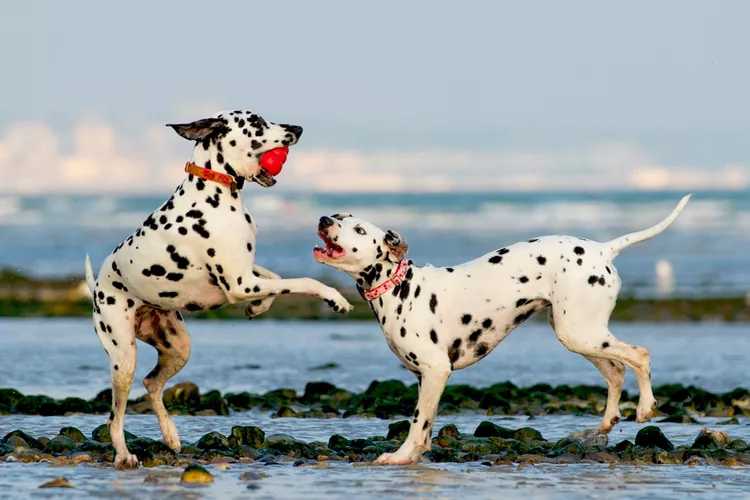
Dalmatians are known for their distinctive coat with spots that are not present at birth but appear as they grow. This spotted pattern results from selective breeding aimed at both looks and function.
These dogs are also genetically prone to high uric acid levels, which can cause kidney stones, also known as urolithiasis. This condition involves the formation of crystal clusters in the kidneys and urinary system.
The breed’s unusual urinary chemistry means they’re at risk for urinary stones, which require careful attention to their diet and regular check-ups to maintain urinary tract health.
The Dalmatian-Pointer Backcross Project introduced a gene variant that helps manage uric acid to combat this issue. This led to the emergence of two Dalmatians: those with Low Uric Acid (LUA) and those with High Uric Acid (HUA).
Stature and Build
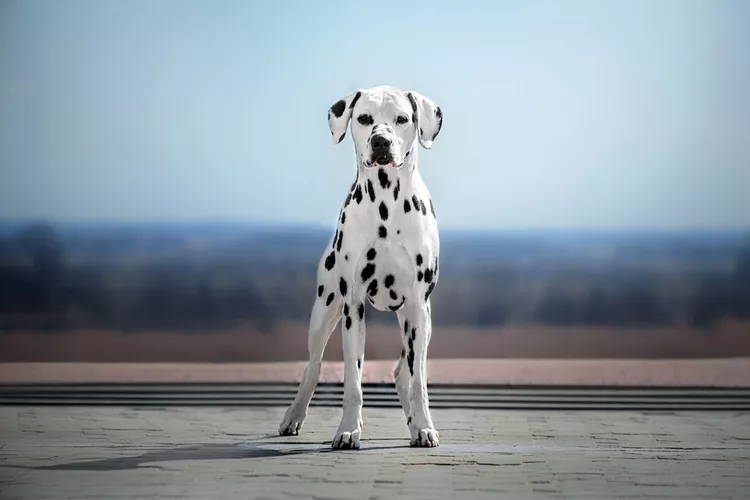
The Dalmatian is known for its impressive stature and robust physique, which includes a strong, athletic body that looks great and performs even better. The breed is defined by a specific height that helps preserve its unique outline. Their weight and the strength of their bones play a massive role in their agility, which Dalmatians are famous for.
- Strong Athletic Body
Dalmatians stand out with their muscular, athletic bodies that enable them to move gracefully and powerfully.
- Specific Height Guidelines
The height guidelines for this breed are precise, ensuring that the dogs maintain their distinctive appearance.
- Importance of Weight and Bone Strength
The balance of their weight and the robustness of their bones are crucial for their impressive agility.
Athletic Muscular Frame
Dalmatians are easily recognized by their unique spotted coats and their heritage as carriage dogs. These dogs are medium-sized with a muscular and athletic body, perfect for their energetic needs. They stand between 19 and 24 inches tall and weigh 45 to 70 pounds, showing off a powerful and balanced form due to their breeding for running next to horse-drawn carriages.
Their sturdy muscles and stamina make them great partners for long-term activities, highlighting why they need to stay active and exercise regularly to keep fit. They must have proper nutrition and a consistent exercise routine to keep their muscles robust and their health in check. They are nimble on their feet because of this care.
It’s also necessary to start training and socializing them early. This helps them channel their energy healthily and positively express their sporty nature.
Ideal Height Range
Continuing the anatomical examination of these canines, an ideal height range of 19-24 inches contributes significantly to the Dalmatian’s balanced and proportionate build, which is essential for their historical role and physical capabilities.
As a medium to large dog breed, Dalmatians exhibit a stature that necessitates a robust and muscular physique to facilitate agility and endurance—traits imperative for their original utilization as carriage dogs.
This optimal stature is also pivotal for sustaining this breed’s alert and dynamic demeanor. Ensuring adherence to the specific height parameters is fundamental for Dalmatians to effectively perform their traditional functions and uphold their innate athletic aptitude, thus preserving the integrity of the breed’s conformational standards.
Weight Proportions
Dalmatians typically weigh between 45 and 70 pounds, reflecting their medium to large size and muscular physique, which is necessary for their work history.
Their bodies are muscular and have short, sleek coats with unique spots ranging from black and liver to blue, brindle, orange, or lemon.
These dogs look solid and quick, but they can have health issues related to their breed. They need regular vet check-ups to look for problems like deafness and urinary issues.
Keeping Dalmatians on a good diet and getting plenty of exercise are vital to reduce critical health risks and keep them energetic.
Bone Structure
Dalmatians are known for their sturdy bone structure and muscular physique, reflecting their medium to large size. This build is ideal for the breed’s active nature and past as working dogs. A solid skeletal framework is critical because they were traditionally used as coach dogs.
But Dalmatians tend to develop hip dysplasia, a hip joint malformation leading to discomfort and movement issues. Owners should regularly check for any signs of joint pain.
Dalmatians also have a unique genetic makeup that makes them prone to urinary stones because of abnormal purine metabolism. To prevent this, a special diet is necessary. Regular vet check-ups are critical to catch and treat health problems early on.
Physical Agility of Dalmatian Rescue
Dalmatians stand at a height of 19 to 24 inches and weigh between 45 and 70 pounds, showcasing a muscular build perfect for activities that demand a lot of physical movement and stamina. These dogs aren’t just any medium-sized breed; they’ve been bred specifically for their ability to keep up with horse-drawn carriages, demonstrating their remarkable endurance over long distances. They’re packed with energy, making them one of the more active dog breeds. A Dalmatian’s well-being needs to engage in plenty of exercise. Without it, they might develop behavioral problems.
To make the most of their energetic nature, it’s best to involve them in exercises challenging their stamina and muscular strength. Activities like this suit their health and make Dalmatians excellent at dog sports. They excel in events that require quick, agile movements and the ability to keep going without getting tired.
Temperament Traits
Dalmatians are known for their complex temperament, combining energetic playfulness and sharp intelligence. They form close bonds with their owners, showing loyalty and love. These dogs need plenty of exercise and mental stimulation due to their energetic nature. They are also smart, which makes them good at following commands and solving problems. With their alertness, Dalmatians make reliable watchdogs, staying on the lookout for anything unusual.
Playful and Energetic Nature
Dalmatians are high-energy and playful dogs that need lots of exercise and brain games to stay happy. They could start misbehaving due to excess energy if they don’t get enough activity.
A family that loves to be active is an excellent match for a Dalmatian because they thrive on games like fetch, agility courses, and learning new tricks. Teaching them to behave and socialize from a young age is critical to ensuring they use their energy well.
They are friendly and love to play, but they can be a bit naughty too. They’re perfect for people or families who enjoy a lively, interactive lifestyle.
Intelligent and Trainable
Dalmatians are intelligent and easy to train. They learn new commands quickly and are known for their ability to follow complex instructions. This intelligence makes them great at determining what their human trainers want. They’re especially receptive to positive feedback, which helps them learn better.
It’s best to start training them when they’re young to make the most of their smarts. This helps prevent any stubborn habits from forming. Dalmatians are also very adaptable, which means they can do well in various roles, from running agility courses to providing comfort as therapy dogs. They’re genuinely multital pets that are a joy to work with.
Affectionate With Families
Building upon their cognitive prowess, Dalmatians exhibit profoundly affectionate familial bonds characterized by loyalty and a penchant for social interaction with household members. This breed’s congenial disposition renders them particularly good with children, underpinned by their dedicated and eager-to-please attitude.
Dalmatians develop deep devotion when integrated into a family unit, often participating zealously in domestic activities. Despite their vibrant energy reserves, they are clownish and tender-hearted, frequently soliciting attention and companionship.
To optimize these traits, early and consistent socialization, coupled with structured training, is indispensable. This ensures their development into well-adjusted, affectionate companions capable of positive and harmonious interactions with young children and other household pets.
High Prey Drive
Exhibiting a high prey drive, Dalmatians possess an innate propensity to chase and capture smaller animals. This trait stems from their historical use as carriage dogs, requiring them to guard horses and coaches from potential threats. This behavioral characteristic is deeply ingrained within their genotype and manifests as a solid instinctual response to moving stimuli.
The Dalmatian Club of America acknowledges this temperament trait, emphasizing the need for early and consistent training to manage this predilection. Owners must often provide ample exercise and mental stimulation to mitigate the manifestation of this drive in undesirable ways.
Dalmatians with a high prey drive need lots of structured physical activities and disciplinary measures to channel their energies constructively and prevent the development of maladaptive behaviors.
Alert and Watchful Behavior
Dalmatians are known for their sharp attentiveness and ability to stay on guard. These dogs make excellent watchdogs because they’re always tuned in to their surroundings and quick to let their owners know if something’s off. They have a knack for keeping an eye on things, a skill they’ve honed since their days as firehouse dogs, where staying alert was critical. This breed is naturally inclined to be a good guardian.
Proper training and socialization can reveal a Dalmatian’s ability to notice details and react swiftly. This makes them even more effective as protectors and allows them to fit into various home settings. Their sharp senses and quick responses help keep their homes safe as they act as reliable defenders for families or those living alone.
Wellness Considerations
To ensure the optimal health of Dalmatians, it is imperative to prioritize comprehensive wellness strategies. These strategies encompass a spectrum of factors, including:
- Health Screening Importance: Proactive genetic and auditory examinations are vital in detecting breed-specific conditions such as hyperuricosuria early.
- Diet and Nutrition Essentials: A diet tailored to the Dalmatian’s unique metabolic needs can mitigate the risk of urolithiasis and support overall health.
- Exercise and Activity Needs: Structured physical activities not only enhance cardiovascular fitness but also contribute to the prevention of behavioral problems stemming from pent-up energy.
Dalmatian Health Conditions
Due to their genetic background, dalmatian dogs must get check-ups. These can help spot and manage inherited issues like deafness and urolithiasis.
Vets use the BAER test to catch hearing problems early. If a Dalmatian is found to be deaf, this information can guide breeding choices and help tailor their training.
Regular urine tests and X-rays are vital to catch urolithiasis early when stones form in the urinary system. Catching these issues early can prevent them from worsening and help Dalmatians live healthier, longer lives.
Diet and Nutrition Essentials
Regular health check-ups are crucial for Dalmatians, but so is their diet. They need the right food to keep them healthy and avoid diet-related problems. Dalmatians need a protein diet to keep their muscles solid, essential fats like Omega-3 for skin health and reducing inflammation, and complex carbohydrates for energy.
They also need lots of water to avoid kidney stones. Special diets can help lower the risk of these stones. Vets can help choose the right food for each dog’s needs, which allows Dalmatians to live longer, healthier lives.
Exercise and Activity Needs
101 Dalmatians are lively dogs that need plenty of exercise to stay healthy and happy. Long walks, jogs, and playful activities should be part of their daily routine. They have a strong instinct to run because they are alongside carriages. Owners must take them for daily walks and let them run alongside freely in safe areas.
Mental exercise is just as important, so activities like agility training and interactive games should be included. Without enough physical and psychological conditioning, Dalmatians can develop behavior problems. Regular exercise is crucial for their overall well-being.
Essential Maintenance Routines
To keep Dalmatians healthy and happy, they need a holistic care plan that addresses their physical and mental requirements. Owners should create a care schedule that includes the following:
- Regular skin and coat care through consistent grooming practices.
- Adequate exercise to prevent behavior problems that can arise from their natural energy levels.
- Routine health check-ups with a vet, specific dietary plans, and ongoing behavior training for overall well-being.
Taking care of a Dalmatian involves several vital aspects.
Skincare is crucial; regular brushing helps to keep their unique coats shiny and healthy.
Exercise is another vital component, as Dalmatians are energetic and need daily activity to stay balanced and well-behaved.
Lastly, a combination of preventive veterinary care, a diet tailored to their needs, and consistent training forms the backbone of a solid healthcare approach for these spotted dogs.
Regular Dalmatian Grooming Needs
To keep your Dalmatian’s coat healthy and looking good, it’s best to brush it weekly using a grooming mitt and a soft cloth. This routine manages shedding and spreads the dog’s natural skin oils. Consistent brushing helps renew the skin and removes loose hair, vital for maintaining a healthy coat. The grooming mitt works well alongside the soft cloth to support the skin’s natural functions.
Regular checks of your dog’s ears are essential to prevent infections, making sure to wax buildup. Since Dalmatians are active, keeping their nails trimmed is a must to avoid painful nail problems. Maintaining these grooming habits is vital to your dog’s overall skin and coat health.
Exercise Needs and Activity
Dalmatians are energetic dogs and need at least 60 minutes of exercise daily to stay healthy. They have muscular bodies and minds that require a lot of physical activity to keep them balanced.
If they don’t get enough exercise, they might start showing unwanted behaviors because they have too much energy. Dalmatian owners must ensure their dogs have plenty of running time, as this breed loves to run.
In addition to physical workouts, Dalmatians also need mental stimulation. Activities like interactive games and puzzles can keep their minds sharp. This combination of body and brain exercises helps prevent health issues and supports a well-rounded lifestyle for these dogs.
Health Check Schedules
For the long-term health of a Dalmatian, it’s vital to stick to an effective health check plan. This includes regular vet visits, tailored diets, daily exercise, thorough grooming, and specific health tests.
Regular checks at the vet help catch and treat breed-specific issues like deafness, which is common in Dalmatians. Early detection can even qualify some as hearing dogs.
A balanced diet prevents urinary problems and infections by providing all the necessary nutrients.
Exercise is not just good for a Dalmatian’s body, but it’s also great for their mental health.
Grooming keeps their coat looking sharp and helps spot any skin issues.
Early health screenings, such as hearing tests and checking uric acid levels, are critical to finding and managing inborn and genetic health concerns.
Diet and Nutrition
Proper nutrition is vital for keeping Dalmatians healthy and full of life. To meet their needs, their diets should be rich in proteins, carbohydrates, fats, vitamins, and minerals.
It’s crucial to prevent urinary stones by giving them the right food. Owners should stick to a regular feeding schedule with set amounts to avoid weight gain, as overweight dogs can’t be as active.
Constant access to clean water is a must but not necessary for urinary health. A vet can help tailor a diet to fit a dog’s health, supporting their active nature and reducing the risk of food-related issues.
Training and Socialization
Training and socialization are essential for Dalmatians to grow well-behaved and comfortable in their surroundings. Starting early is critical, as it is proven that introducing a Dalmatian puppy to new people, other dogs, and animals leads to friendlier behavior. Using rewards to encourage good behavior helps manage their stubborn streak. Keeping their minds active with different tasks and lessons prevents boredom, which can lead to them acting out.
Exposing them to various situations helps them become less fearful and more confident. Dalmatians need a lot of exercise to use their natural energy, which keeps them mentally and physically healthy, as the American Kennel Club recommends.
Nutritional Requirements
The proper diet for proportions is crucial because of their unique health requirements. Their food should help maintain a healthy metabolism and reduce the risk of kidney stones.
Here are some key aspects to consider for their meal plan:
- Essentials of a Balanced Diet: It’s important to get the mix right with proteins, carbs, fats, vitamins, and minerals.
- Exceptional Food Choices: Choose foods with low levels of purines and keep their urine pH neutral to help prevent urate stones.
- Meal Times and Sizes: Regular meal times and correct portion sizes can help prevent weight gain.
These guidelines will help you provide a healthy diet for your Dalmatian.
Balanced Diet Essentials
A Dalmatian’s diet should contain high-quality protein, essential fatty acids, and vitamins and minerals. This supports their overall health and keeps their distinctive spotted coat in good condition.
Because Dalmatians have stones, controlling the amount of purine in their food is essential. They need plenty of water to help flush out their kidneys and avoid these painful stones.
Carbs are necessary for Dalmatians since they’re a high-energy breed, but balancing their intake is vital to preventing weight gain. Adding fruits and veggies to their diet can boost their immune system.
Since Dalmatians can have food sensitivities, working with a vet to create a personalized diet plan is brilliant. This ensures that their nutritional needs are met without causing any health issues.
Special Dietary Considerations
Considering the unique metabolism of Dalmatians, it’s crucial to have a diet that controls purine levels to prevent urate stone formation. Dalmatians are beautiful dogs with distinctive spots and special dietary needs due to a genetic issue that can cause urinary stones.
It’s essential to lower purine in their food, as this turns into uric acid, which can lead to stones. We need to pick high-quality, low-purine proteins to keep them healthy and maintain their eye-catching coats. Including omega-3 fatty acids in their diet can help keep their skin healthy.
Always consult a vet to get the right diet plan for your Dalmatian, ensuring they stay healthy and avoid urinary issues.
Feeding Frequency & Portions
Monitoring purine levels is critical for Dalmatians’ health, as is managing how often and how much they eat. This helps keep their metabolism steady and their weight in check.
Dalmatians, known for their unique spotted coats, should eat twice daily to keep their energy up and balanced. They’re prone to developing urinary stones, so it’s vital to measure their food carefully to avoid this issue. A regular feeding routine also helps their digestion and reduces the chance of stomach problems like bloat.
Since Dalmatians tend to gain weight quickly, watching how much they eat is essential. A vet can advise on the best feeding plan for your Dalmatian, considering their age, size, and activity level.
